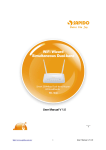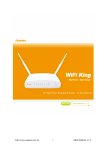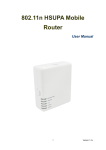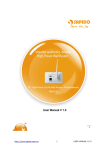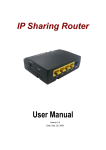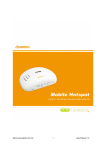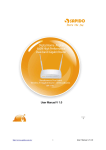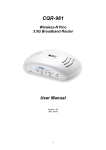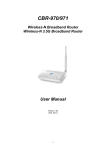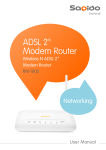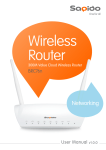Download http://www.sapido.com.tw/ User Manual v1.0.0 1
Transcript
http://www.sapido.com.tw/ 1 User Manual v1.0.0 FCC Statement Federal Communication Commission Interference Statement This equipment has been tested and found to comply with the limits for a Class B digital device, pursuant to Part 15 of the FCC Rules. These limits are designed to provide reasonable protection against harmful interference in a residential installation. This equipment generates, uses and can radiate radio frequency energy and, if not installed and used in accordance with the instructions, may cause harmful interference to radio communications. However, there is no guarantee that interference will not occur in a particular installation. If this equipment does cause harmful interference to radio or television reception, which can be determined by turning the equipment off and on, the user is encouraged to try to correct the interference by one of the following measures: Reorient or relocate the receiving antenna. Increase the separation between the equipment and receiver. Connect the equipment into an outlet on a circuit different from that to which the receiver is connected. Consult the dealer or an experienced radio/TV technician for help. FCC Caution 1. The device complies with Part 15 of the FCC rules. Operation is subject to the following conditions: 2. This device may not cause harmful interference, and this device must accept any interference received, including interference that may cause undesired operation. 3. FCC RF Radiation Exposure Statement: The equipment complies with FCC RF radiation exposure limits set forth for an uncontrolled environment. This equipment should be installed and operated with a minimum distance of 20 centimeters between the radiator and your body. 4. This Transmitter must not be co-located or operating in conjunction with any other antenna or transmitter. 5. Changes or modifications to this unit not expressly approved by the party responsible for compliance could void the user authority to operate the equipment. IMPORTANT NOTE FCC Radiation Exposure Statement: This equipment complies with FCC radiation exposure limits set forth for an uncontrolled environment. This equipment should be installed and operated with minimum distance20cm between the radiator & your body. http://www.sapido.com.tw/ 2 User Manual v1.0.0 CE Mark Warning This is a class B product. In a domestic environment, this product may cause radio interference, in which case the user may be required to take adequate measures. National Restrictions Frequency range - 2400.0 - 2483.5 MHz Country Bulgaria France Italy Luxembourg Norway Russian Federation Country Reason/remark General authorization required for outdoor use none and public service. Military Radiolocation use. Refarming of the 2.4 Outdoor use limited to 10 GHz band has been ongoing in recent years to mW e.i.r.p. within the allow current relaxed regulation. Full band 2454-2483.5 MHz implementation planned 2012. If used outside of own premises, general none authorization is required. General authorization required for network and none service supply (not for spectrum). This subsection does not apply for the Implemented geographical area within a radius of 20 km from the centre of Ny-Ålesund. none Only for indoor applications. Note: Please don’t use the product outdoors in France CE Statement of Conformity Our product has been tested in typical configuration by Ecom Sertech Corp and was found to comply with the essential requirement of "Council Directive on the Approximation of the Laws of the Member Sates relating to Electromagnetic Compatibility" (89/336/EEC; 92/31/EEC; 93/68/EEC). The Declaration of Conformity can be found at the Sapido regional website. www.sapidotech.de CE Information of Disposal The electric and electronic equipment or unit which is labeled with crossed-out wheeled bin may not be disposed of with household waste. This mark is based on European Directive 2002/96/EC (for Waste Electric and Electronic Equipment=WEEE). Please take it to the designated collection facilities. We will ensure the proper recycling, reuse and other forms of recovery of WEEE. WEEE has the potential effects on the environment and human health as a result of the presence of hazardous substances. You can contribute to eliminate these effects by your cooperation. http://www.sapido.com.tw/ 3 User Manual v1.0.0 Table of Contents Chapter 1 Introduction ................................................................................................................. 7 1.1 Specifications.............................................................................................................. 7 1.2 Product Appearance ................................................................................................... 8 Chapter 2 System and Network Setup......................................................................................10 2.1 Build Network Connection .......................................................................................10 2.1.1 Router Mode......................................................................................................10 2.1.2 AP Mode ............................................................................................................ 11 2.1.3 Wi-Fi AP Mode................................................................................................... 11 2.2 Connecting SAPIDO RB-1733 .................................................................................. 11 2.3 Network setup ...........................................................................................................12 2.3.1 Windows 2000...................................................................................................13 2.3.2 Windows XP ......................................................................................................14 2.3.3 Windows Vista / Windows 7 ............................................................................15 2.4 Router IP Address Lookup.......................................................................................16 2.4.1 Chapter 3 Log into Web GUI .............................................................................................17 Internet Connection ..................................................................................................18 3.1 Plug and Play.............................................................................................................19 3.1.1 3.2 Smart Phone /iPhone Internet sharing plug and play ..................................19 Router Mode- Using as a broadband router...........................................................20 3.2.1 WAN Interface- Ethernet Port ..........................................................................21 3.2.1.1 Static IP ................................................................................................................ 21 3.2.1.2 DHCP Client ......................................................................................................... 23 3.2.1.3 PPPoE................................................................................................................... 24 3.2.1.4 PPTP ..................................................................................................................... 26 3.2.1.5 L2TP...................................................................................................................... 27 3.2.1.6 Advance function ................................................................................................ 29 3.2.2 WAN Interface- 3G USB dongle.......................................................................29 3.2.3 WAN Interface- Wireless ..................................................................................31 3.3 AP Mode-Using as a Access Point ..........................................................................32 3.4 WiFi AP Mode- Using as a Network Converter.......................................................34 Chapter 4 Wireless Setup ..........................................................................................................37 4.1 4.2 Wireless Setup ..........................................................................................................37 4.1.1 Setup Wireless LAN by WPS button ..............................................................37 4.1.2 Wireless Basic Setup from Web GUI ..............................................................39 4.1.2.1 Multiple APs ......................................................................................................... 41 4.1.2.2 Enable Universal Repeater Mode ....................................................................... 42 Wireless Security Setup ...........................................................................................43 http://www.sapido.com.tw/ 4 User Manual v1.0.0 4.3 Wireless Access Control ..........................................................................................46 Chapter 5 Router Mode Security Setup....................................................................................48 5.1 NAT .............................................................................................................................48 5.1.1 Virtual Server ....................................................................................................48 5.1.2 Virtual DMZ........................................................................................................49 5.2 Firewall.......................................................................................................................50 5.2.1 QoS ....................................................................................................................50 5.2.2 Port Filtering .....................................................................................................52 5.2.3 IP Filtering .........................................................................................................53 5.2.4 Mac Filter Schedule..........................................................................................54 5.2.5 URL Filtering .....................................................................................................54 Chapter 6 Advanced Setup ........................................................................................................56 6.1 Dynamic DNS Setting 6.2 Wireless Advanced Setup ........................................................................................57 6.2.1 Wireless Site Survey 6.2.2 WDS Settings 6.2.3 WPS 6.3 Chapter 7 7.1 ....................................................................58 ..............................................................59 ...............................................................................63 System Management ................................................................................................65 6.3.1 Change Password ............................................................................................66 6.3.2 Firmware Upgrade............................................................................................66 6.3.3 Profile Save .......................................................................................................67 6.3.4 Time Zone Setting ............................................................................................70 6.3.5 UPnP Setting.....................................................................................................71 6.3.6 VPN Passthrough Setting................................................................................71 6.3.7 Language Setting .............................................................................................72 6.4 6.5 .............................................................................56 Log & Status ..............................................................................................................72 6.4.1 Network Config.................................................................................................73 6.4.2 Event Log ..........................................................................................................74 Logout ........................................................................................................................75 Samba Server ............................................................................................................76 How to use SAPIDO RB-1733 as a Samba server..................................................76 Chapter 8 DDNS Service Application........................................................................................77 Chapter 9 Q & A ..........................................................................................................................82 9.1 Installation .................................................................................................................82 9.2 LED .............................................................................................................................82 9.3 IP Address..................................................................................................................82 9.4 OS Setting..................................................................................................................83 9.5 SAPIDO RB-1733 Setup............................................................................................85 http://www.sapido.com.tw/ 5 User Manual v1.0.0 9.6 Wireless LAN .............................................................................................................86 9.7 Support ......................................................................................................................88 9.8 Others.........................................................................................................................89 9.9 USB Device ................................................................................................................89 Chapter 10 Appendices................................................................................................................90 10.1 Operating Systems ...................................................................................................90 10.2 Browsers....................................................................................................................90 10.3 Communications Regulation Information ..............................................................90 http://www.sapido.com.tw/ 6 User Manual v1.0.0 Chapter 1 1.1 Introduction Specifications Network Standards Data Rate Frequency Range Wireless Security Session Firewall Operation Modes Network Features Mobile (External): 3G/4G USB Modem WLAN: IEEE 802.11n, 802.11g, 802.11b WAN: xDSL/Cable Modem 3G/4G: Depending on actual service speed WiFi: 802.11n (Max 300Mbps), 802.11g (Max 54Mps), 802.11b (Max 11Mbps) LAN: 802.3/802.3u (10/100Mbps) 2.412~2.484GHz WEP 64 or 128 bit/WPA/WPA2/WPA2 Mixed, WPS (PBC/PIN), WDS, Multiple Aps 100,000 MAC Address Filtering, URL Filtering, IP/Port Based Filtering UPnP, DHCP, DDNS, DNS Router, AP, WiFi AP NAT: DMZ Host, Port-Redirection / Virtual server / VPN pass-trough Hardware Antenna WAN LAN LED Indicator Power Adapter Operating Temperature Dimension Management 5 dBi x2 (External) 1 x 10/100/1000Mbps RJ45, with auto MDI/MDIX 4 x 10/100/1000Mbps RJ45, with auto MDI/MDIX Power, Status, WAN, LAN (1~4), Wireless/WPS DC 12V Operating: 0ºC ~40ºC (32ºF ~104ºF) Storage: -20ºC ~70ºC (-4ºF ~158ºF) Operating: 10% to 85% Non-Condensing Storage: 5% to 90% Non-Condensing 198 x 107 x 39 mm (4.65 x 2.75 x 0.98 inch) (Antenna not included) Web GUI, Firmware upgrade via web Wireless Chip Realtek RTL8192CE (MAC+BB+RF) 2T2R with external high power PA Humidity http://www.sapido.com.tw/ 7 User Manual v1.0.0 1.2 Product Appearance The Front LED Indicator Status Description: Status Solid Flashing Power Operation OK - Status System ready Reset / Firmware updates in progress WAN Ethernet connected Transmitting Data LAN (1~4) Ethernet connected Transmitting Data WIRELESS & WPS Operation OK Green: Transmitting Data Orange: WPS enabled LED Indicator The Rear http://www.sapido.com.tw/ 8 User Manual v1.0.0 Power DC Jack DC 12V power in Reset Button Press for back to factory default USB Port For 3G/4G modem only Ethernet Port (LAN 1~4) RJ-45 Ethernet 10/100/1000 Ports Ethernet Port (WAN) RJ-45 Ethernet 10/100/1000 Port http://www.sapido.com.tw/ 9 User Manual v1.0.0 Chapter 2 System and Network Setup The SAPIDO RB-1733 is an easy to setup and wireless device for various application and environment, especially for large installs such as hotels, offices space, warehouses, hot-spots and more. To begin with SAPIDO RB-1733, you must have the following minimum system requirements. If your system can’t correspond to the following requirements, you might get some unknown troubles on your system. Internet Account for XDSL/Cable Modem, or 3G. One Ethernet (10 BASE-T, 10/100 BASE-TX or 10/100/1000 BASE-TX) network interface card. TCP/IP and at least one web browser software installed (E.g.: Internet Explorer 6.0, Netscape Navigator 7.x, Apple Safari 2.03 or higher version). At lease one 802.11g (54Mbps) or one 802.11b (11Mbps) wireless adapter for wireless mobile clients. 2.1 Recommended OS: WinXP, Visata or Win7 / Linux. Build Network Connection Administrator can manage the settings for WAN, LAN, Wireless Network, NTP, password, User Accounts, Firewall, etc. Please confirm the network environment or the purpose before setting this product. 2.1.1 Router Mode Switch to router mode through web GUI when the first setup. http://www.sapido.com.tw/ 10 User Manual v1.0.0 2.1.2 AP Mode Switch to AP mode, if a router is already set at the house, and you want to make the wireless LAN communication. 2.1.3 Wi-Fi AP Mode Switch to WiFi AP Mode when you connect to the internet wirelessly through PC and wireless device without wireless LAN function equipped. 2.2 Connecting SAPIDO RB-1733 Prepare the followings before the connection: PC or Notebook for setup Ethernet cable or 3G modem http://www.sapido.com.tw/ 11 User Manual v1.0.0 1. Make sure you are under “Router Mode”. 2. Connect SAPIDO RB-1733 to xDSL/ Cable modem with the Ethernet cable, WAN to LAN. 3. 2.3 Turn on your Computer. Network setup http://www.sapido.com.tw/ 12 User Manual v1.0.0 After the network connection is built, the next step is setup the router with proper network parameters, so it can work properly in your network environment. Before you connect to the wireless router and start configuration procedures, your computer must be able to get an IP address from the wireless router automatically (use dynamic IP address). If it’s set to use static IP address, or you’re unsure, please follow the below instructions to configure your computer with dynamic IP address: If the operating system of your computer is…. Windows 2000 - please go to section 2.3.1 Windows XP - please go to section 2.3.2 Windows Vista/Win7 - please go to section 2.3.3 2.3.1 Windows 2000 Click “Start” button (it should be located at lower-left corner of your computer), then click control panel. Double-click Network and Dial-up Connections icon, double click Local Area Connection, and Local Area Connection Properties window will appear. Select “Internet Protocol (TCP/IP)”, then click “Properties”. 1. Select “Obtain an IP address automatically” and “Obtain DNS server address automatically”, then click “OK”. http://www.sapido.com.tw/ 13 User Manual v1.0.0 2.3.2 1. Windows XP Click “Start” button (it should be located at lower-left corner of your computer), then click control panel. Double-click Network and Internet Connections icon, click Network Connections, then double-click Local Area Connection, Local Area Connection Status window will appear, and then click “Properties”. 2. Select “Obtain an IP address automatically” and “Obtain DNS server address automatically”, then click “OK”. http://www.sapido.com.tw/ 14 User Manual v1.0.0 2.3.3 1. Windows Vista / Windows 7 Click “Start” button (it should be located at lower-left corner of your computer), then click control panel. Click View Network Status and Tasks, and then click Manage Network Connections. Right-click Local Area Network, then select “Properties”. Local Area Connection Properties window will appear, select “Internet Protocol Version 4 (TCP / IPv4)”, and then click “Properties”. http://www.sapido.com.tw/ 15 User Manual v1.0.0 2. Select “Obtain an IP address automatically” and “Obtain DNS server address automatically”, then click “OK”. 2.4 Router IP Address Lookup After the IP address setup was completed, please clicks “start” → “run” at the bottom-lower corner of your desktop: http://www.sapido.com.tw/ 16 User Manual v1.0.0 Input “cmd”, and then click “OK”. Input “ipconfig”, then press “Enter” key. Please check the IP address followed by “Default Gateway” (In this example, the gateway IP address of router is 192.168.1.1) NOTE: If the IP address of Gateway is not displayed, or the address followed by ‘IP Address’ begins with “169.x.x.x”, please recheck network connection between your computer and router, and / or go to the beginning of this chapter, to recheck every step of network setup procedure. 2.4.1 Log into Web GUI After your computer obtained an IP address from wireless router, please start your web browser, and input the IP address of the wireless router in address bar, and the following message should be shown. Please click “admin” to login the SAPIDO RB-1733. Enter the User name and Password in to the blank and then Click Login. The default values for User Name and Password are admin (all in lowercase letters). http://www.sapido.com.tw/ 17 User Manual v1.0.0 Chapter 3 Internet Connection This Chapter describes how to setup SAPIDO RB-1733 to the internet. http://www.sapido.com.tw/ 18 The SAPIDO User Manual v1.0.0 RB-1733 is delivered with the following factory default parameters. Default IP address: 192.168.1.1 (Router Mode) 192.168.1.254 (AP Mode) 192.168.1.254 (WiFi AP Mode) Default IP subnet mask: 255.255.255.0 Web login user name: admin Web login password: admin 3.1 Plug and Play The SAPIDO RB-1733 supports four types of Internet connection method: 3G modem card, wire or wireless connection via xDSL/Cable modem. Just connect the 3G modem card or Ethernet cable to SAPIDO RB-1733, the router will recognize it automatically. 3.1.1 Smart Phone /iPhone Internet sharing plug and play With SAPIDO RB-1733, you can build an instant 802.11n wireless broadband sharing environment with your iPhone, Windows Mobile or Google smart phone. During the time you can still answer calls, send SMS and charge your phone. Step 1. Connect iPhone/Smart phone with SAPIDO RB-1733 via USB cable. http://www.sapido.com.tw/ 19 User Manual v1.0.0 Step 2. Select “USB Tethering” as connection type. Step 3. Click on “Done”. Step 4. Wait few seconds for pairing. When WAN LED on, the Internet is ready to access. Note: 1. iPhone: (1) Due to difference in 3G service bundled in various carriers, please check your 3G service supports Internet tethering. (2) Enable Internet Tethering on iPhone 3GS / iPhone 4, and set up the screen lock to never to prevent the sharing is interrupted unexpected by the iPhone screen lock feature. 2. Google Android Phone: please turn on "USB modem mode” when connecting router. 3. Window Mobile Phone: please enable “USB to PC” function. 3.2 Router Mode- Using as a broadband router http://www.sapido.com.tw/ 20 User Manual v1.0.0 Open a Web browser, and enter http://192.168.1.1 (Default Gateway) into the blank. Enter the User name and Password into the blank and then click Login. The default values for User Name and Password are admin (all in lowercase letters). 3.2.1 WAN Interface- Ethernet Port The WAN access type is depended on the service that you contract with the provider. The SAPIDO RB-1733 provides five selections for the WAN access type, Static IP, DHCP Client, PPPoE, PPTP and L2TP. 3.2.1.1 Check with your ISP if you don’t know the WAN type. Static IP Select WAN under the IP Config menu, and choose Ethernet Port for the WAN Interface. Its http://www.sapido.com.tw/ 21 User Manual v1.0.0 associated setting will show up. Item Description WAN Access Type Select “Static IP” IP Address Enter the IP address which is provided by your ISP. Subnet Mask Please enter the Subnet Mask address Default Gateway Input ISP Default Gateway Address, . DNS Input DNS information which is provided by your ISP http://www.sapido.com.tw/ 22 User Manual v1.0.0 Backup select Select 3G as a back up solution or none. Clone Mac Address Some ISPs require MAC address registration. In this case, enter the MAC address registered to the provider to "Clone MAC Address" Apply Change & Reset Click on Apply Change to save the setting date, or you may click on Reset to clear all the input data. 3.2.1.2 DHCP Client Item Description WAN Access Type Select "DHCP Client" http://www.sapido.com.tw/ 23 User Manual v1.0.0 Host Name You can keep the default as the host name, or input a specific name if required by your ISP. DNS Select Attain DNS Automatically. Or select Set DNS Manually, if you want to specify the DNS, and enter the DNS provided by your ISP in DNS 1 2 3. Backup select Select 3G as a back up solution or none. Clone Mac Address Some ISPs require MAC address registration. In this case, enter the MAC address registered to the provider to "Clone MAC Address" Apply Change & Reset Click on Apply Change to save the setting date, or you may click on Reset to clear all the input data. 3.2.1.3 PPPoE http://www.sapido.com.tw/ 24 User Manual v1.0.0 Item Description WAN Access Type Select "PPPoE" User Name Input your user name provided by your ISP. If you don’t know, please check with your ISP. Password Input the password provided by your ISP. Service Name Input the service name provided by your ISP. Connection Type Three types for select: Continues, Connect on Demand, and Manual. DNS Select Attain DNS Automatically. Or select Set DNS Manually, if you want to specify the DNS, and enter the DNS provided by your ISP in DNS 1 2 3. Backup select Select 3G as a back up solution or none. Clone Mac Address Some ISPs require MAC address registration. In this case, enter the MAC address registered to the provider to "Clone MAC Address" Apply Change & Reset Click on Apply Change to save the setting date, or you may click on Reset to clear all the input data. http://www.sapido.com.tw/ 25 User Manual v1.0.0 3.2.1.4 PPTP Item Description WAN Access Type Select "PPTP" Server IP Address Input your server IP address provided by your ISP. If you don’t know, please check with your ISP. http://www.sapido.com.tw/ 26 User Manual v1.0.0 User Name Input PPTP account provided by your ISP. Password Input the password provided by your ISP. DNS Select Attain DNS Automatically. Or select Set DNS Manually, if you want to specify the DNS, and enter the DNS provided by your ISP in DNS 1 2 3. Backup select Select 3G as a back up solution or none. Clone Mac Address Some ISPs require MAC address registration. In this case, enter the MAC address registered to the provider to "Clone MAC Address" Apply Change & Reset Click on Apply Change to save the setting date, or you may click on Reset to clear all the input data. 3.2.1.5 L2TP http://www.sapido.com.tw/ 27 User Manual v1.0.0 Item Description WAN Access Type Select "PPTP" Server IP Address / Host Name Input your server IP address or Host Name provided by your ISP. If you don’t know, please check with your ISP. User Name Input PPTP account provided by your ISP. Password Input the password provided by your ISP. DNS Select Attain DNS Automatically. Or select Set DNS Manually, if you want to specify the DNS, and enter the DNS provided by your ISP in DNS 1 2 3. http://www.sapido.com.tw/ 28 User Manual v1.0.0 Backup select Select 3G as a back up solution or none. Clone Mac Address Some ISPs require MAC address registration. In this case, enter the MAC address registered to the provider to "Clone MAC Address" Apply Change & Reset Click on Apply Change to save the setting date, or you may click on Reset to clear all the input data. 3.2.1.6 Advance function Item Description MTU Maximum Transmission Unit. Usually provide by computer operation systems (OS). Advanced users can set it manually. Request MPPE Encryption Microsoft Point-to-Point Encryption (MPPE) provides data security for the PPTP connection that is between the VPN client and VPN server. Enable IGMP Proxy Enable IGMP Proxy to provide the service for IP hosts and adjacent multicast routers to establish multicast group memberships. Enable Ping Access on WAN Enable Ping Access on WAN will make WAN IP address response to any ping request from Internet users. However, it is also a comma way for hacker to ping public WAN IP address, to see is there any WAN IP address available. Enable Web Server Access on WAN This option is to enable Web Server Access function on WAN. 3.2.2 WAN Interface- 3G USB dongle Select WAN under the IP Config menu, and choose 3G usb dongle for the WAN Interface. Its associated setting will show as below. http://www.sapido.com.tw/ 29 User Manual v1.0.0 Item Description APN (Access Point Name) Enter the access point name. If you do not know the setting information for APN, check with your 3G service provider. User Name Enter the User Name supplied by the provider. Password Enter the password supplied by the provider. Phone Number Enter the subscribing access point's phone number. DNS Select Attain DNS Automatically. Or select Set DNS Manually, if you want to specify the DNS, and enter the DNS provided by your ISP in DNS 1 2 3. Clone Mac Address Some ISPs require MAC address registration. In this case, enter the MAC address registered to the provider to "Clone MAC Address" Always / Dial on demand If your 3G USB adapter is a pay-as-you-go plan base, select “Dial on demand” and disconnect the connection when you don't use the http://www.sapido.com.tw/ 30 User Manual v1.0.0 internet. Enable IGMP Proxy Enable IGMP Proxy to provide the service for IP hosts and adjacent multicast routers to establish multicast group memberships. Enable Ping Access on WAN Enable Ping Access on WAN will make WAN IP address response to any ping request from Internet users. However, it is also a comma way for hacker to ping public WAN IP address, to see is there any WAN IP address available. Enable Web Server Access on WAN This option is to enable Web Server Access function on WAN. Apply Change Click “Finish” to complete the setting Rebooting this product is started. 3.2.3 Please wait for a while. WAN Interface- Wireless Select WAN under the IP Config menu, and choose wireless for the WAN Interface. Its associated setting will show as below. http://www.sapido.com.tw/ 31 User Manual v1.0.0 Item Description Refresh You can see a list of available Wireless networks. Select the preferred one. Encryption type Select the Encryption type form the drop-down list. WAN Access Type Select Static IP, DHCP, PPPoE, PPTP or L2TP. DNS Select Attain DNS Automatically. Or select Set DNS Manually, if you want to specify the DNS, and enter the DNS provided by your ISP in DNS 1 2 3. Clone Mac Address Some ISPs require MAC address registration. In this case, enter the MAC address registered to the provider to "Clone MAC Address" Apply Change & Reset Click on Apply Change to save the setting date, or you may click on Reset to clear all the input data. 3.3 AP Mode-Using as a Access Point http://www.sapido.com.tw/ 32 User Manual v1.0.0 Make sure to shift the mode into AP Mode. When this product is used as an access point, the IP address has to be changed. The default IP under AP mode is 192.168.1.254. 1. Open a Web browser, and enter http://192.168.1.254 (Default Gateway) into the blank. 2. Enter the User name and Password in to the blank and then Click Login. The default values for User Name and Password are admin (all in lowercase letters). Select LAN under the IP Config menu http://www.sapido.com.tw/ 33 User Manual v1.0.0 Item Description Device Name Input a name for this router. IP Address The default IP address is 192.168.1.254 Subnet Mask Enter the Subnet Mask address Default Gateway Enter the Default Gateway address for LAN interfaces DHCP Select DHCP type: Client, Disable, or Server under different environment. DHCP Client Range When enable DHCP server, you can fill in the start and end IP address; client will be assigned an IP address from the range. 802.1d Spanning Tree Disable or Enable the 802.1d Spanning Tree Protocol (STP) Clone Mac Address Some ISPs require MAC address registration. In this case, enter the MAC address registered to the provider to "Clone MAC Address" Apply Change & Reset Click on Apply Change to save the setting date, or you may click on Reset to clear all the input data. 3.4 WiFi AP Mode- Using as a Network Converter Make sure to shift the mode into WiFi AP Mode. http://www.sapido.com.tw/ 34 User Manual v1.0.0 The default gateway is http://192.168.1.254 and for User Name and Password are admin (all in lowercase letters). Click Login to enter. http://www.sapido.com.tw/ 35 User Manual v1.0.0 Item Description Device Name Input a name for this router. IP Address The default IP address is 192.168.1.254 Subnet Mask Enter the Subnet Mask address Default Gateway Enter the Default Gateway address for LAN interfaces DHCP Select DHCP type: Client, Disable, or Server under different environment. DHCP Client Range When enable DHCP server, you can fill in the start and end IP address; client will be assigned an IP address from the range. 802.1d Spanning Tree Disable or Enable the 802.1d Spanning Tree Protocol (STP) Clone Mac Address Some ISPs require MAC address registration. In this case, enter the MAC address registered to the provider to "Clone MAC Address" Apply Change & Reset Click on Apply Change to save the setting date, or you may click on Reset to clear all the input data. http://www.sapido.com.tw/ 36 User Manual v1.0.0 Chapter 4 4.1 Wireless Setup Wireless Setup There are two ways to setup wireless LAN with SAPIDO RB-1733. You can use either way to setup Wireless LAN. 4.1.1 Setup Wireless LAN by WPS button You can setup wireless LAN easily by using the WPS button if both WLAN router and the WLAN adapter (client) are WPS supported. Before starting the setup, please check the things below: Get ready for Internet connection with SAPIDO RB-1733 The WLAN adapter is finished installation and plug in your computer/ laptop. There are two ways to setup a wireless LAN between SAPIDO RB-1733 and your wireless adapter: 1. Setup with WPS button, if your wireless adapter has a physical WPS button. (1) Press the WPS button (A) from SAPIDO RB-1733 and wait for Wireless/WPS LED light (B) changed into orange. (2) Press the WPS button (C) from the adapter until the setup window shows up. (3) Open a web browser to check the internet connection. http://www.sapido.com.tw/ 37 User Manual v1.0.0 (4) Setup without WPS button if you wireless adapter has only virtual WPS function. (5) Open Wireless adapter utility. (6) Press the WPS button (A) from SAPIDO RB-1733 and wait for Wireless/WPS LED light (B) changed into orange. (7) Back to the WLAN adapter utility and click its “PBC” (C) button. http://www.sapido.com.tw/ 38 User Manual v1.0.0 The utility will start searching the destination connection. (8) Confirm the information form the Utility (9) After completes the WPS setup. Please confirm that it can be connected to the Internet. Note: The setup image might be some differences when using other branded Adapter. 4.1.2 Wireless Basic Setup from Web GUI The Wireless Basic Settings include Band, Mode, SSID, Channel Number and other wireless settings. http://www.sapido.com.tw/ 39 User Manual v1.0.0 Item Description Disable Wireless LAN Interface Turn off the wireless service. Band Select the frequency. It has 6 options: 2.4 GHz (B/G/N/B+G/G+N/B+G+N). Mode Select the mode. It has 3 modes to select: (AP, Client, WDS, AP+WDS). Multiple AP: Please check Section 4.1.2.1. http://www.sapido.com.tw/ 40 User Manual v1.0.0 * In Wi-Fi AP mode only support Client mode. SSID Service Set identifier, users can define to any or keep as default. Channel Width Please select the channel width, it has 2 options: 20MHZ, and 40MHZ. Control Sideband Enable this function will control your router use lower or upper channel. Channel Number Please select the channel; it has Auto, 1, 2~11 or 13 options. Broadband SSID User may choose to enable Broadcast SSID or not. Data Rate Please select the data transmission rate. Associate Clients Check the AP connectors and the Wireless connecting status. Enable MAC Clone (Single Ethernet Client) Clone the MAC address for ISP to identify. Enable Universal Repeater Mode (Acting as AP and Client simultaneously) Allow to equip with the wireless way conjunction upper level, provide the bottom layer user link in wireless and wired way in the meantime. (The IP that bottom layer obtains is from upper level.) Please also check Section 4.1.2.2 SSID of Extended Interface While linking the upper level device in wireless way, you can set SSID to give the bottom layer user search. Apply Change & Reset Click on Apply Change to save the setting date, or you may click on Reset to clear all the input data. * Under WiFi AP Mode, there are 2 options of Network type: Infrastructure or Ad hoc. Select Infrastructure if connecting to a wireless router or access point. Select Ad hoc if connecting directly to another wireless adapter. 4.1.2.1 Multiple APs The SAPIDO RB-1733 can register up to 4 SSIDs (wireless LAN RBoup). if there are multiple wireless LAN access points with one product. It can be used as Each SSID could be set with different data rate, WMM and access type. http://www.sapido.com.tw/ 41 User Manual v1.0.0 Item Description Enable Enable or disable the service. Band Select the frequency. SSID Enter the SSID Data Rate Select the data transmission rate. Access Enable this function can let clients use two access types: a. LAN+WAN: the client can access to the Internet and access in the router’s GUI. Active Client List Apply Change & Reset 4.1.2.2 b. WAN: the client can only access to the Internet. Display the properties of the client which is connecting successfully. Click on Apply Change to save the setting date, or you may click on Reset to clear all the input data. Enable Universal Repeater Mode The router can act as Station and AP at the same time. It can use Station function to connect to a Root AP and use AP function to service all wireless stations within its coverage. http://www.sapido.com.tw/ 42 User Manual v1.0.0 Example: When users enable the Universal Repeater to connect to the upper level device, please fill in the upper level device s channel and SSID. Click on Apply Changes to save the settings. (Please disable the DHCP service first) Users can use the Network Configuration page to check the information about “Wireless Repeater Interface Configuration”. 4.2 Wireless Security Setup http://www.sapido.com.tw/ 43 User Manual v1.0.0 Here users define the security type and level of the wireless network. Selecting different methods provides different levels of security. Please note that using any encryption may cause a significant deRBadation of data throughput on the wireless link. There are five Encryption types supported: “None”, “WEP”, “WPA (TKIP)”, ”WPA2(AES)”, and “WPA2 Mixed”. Enabling WEP can protect your data from eavesdroppers. If you do not need this feature, select “None” to skip the following setting. http://www.sapido.com.tw/ 44 User Manual v1.0.0 1. Encryption- WEP Key (1) Set WEP Key: This section provides 64bit and 128bit WEP encryptions and two different shared key formats (ASCII and Hex) for wireless network. (2) 802.1x Authentication It is a safety system by using authentication to protect your wireless network. 2. Encryption- WPA (WPA, WPA2, and WPA2 Mixed), WPA Authentication Mode (1) Enterprise (RADIUS): Please fill in the RADIUS server Port, IP Address, and Password http://www.sapido.com.tw/ 45 User Manual v1.0.0 (2) Personal (Pre-Shared Key): Pre-Shared Key type is ASCII Code; the length is between 8 to 63 characters. If the key type is Hex, the key length is 64 characters. (3) Apply Change & Reset: Click on ‘Apply Changes’ to save setting data. Or click ‘Reset’ to reset all the input data. 4.3 Wireless Access Control Access Control allows user to block or allow wireless clients to access this router. Users can select the access control mode, then add a new MAC address with a simple comment and click on “Apply Change” to save the new addition. To delete a MAC address, select its corresponding checkbox under the Select column and click on “Delete Selected” button. Take the wireless card as the example. (1) Please select Deny Listed in Wireless Access Control Mode first, and then fill in the MAC http://www.sapido.com.tw/ 46 User Manual v1.0.0 address what you plan to block in the MAC Address field. Click Apply Changes to save the setting. (2) The MAC address what you set will be displayed on the Current Access Control List. (3) The wireless client will be denied by the wireless router. http://www.sapido.com.tw/ 47 User Manual v1.0.0 Chapter 5 Router Mode Security Setup This section contains configurations for the SAPIDO RB-1733’s advanced functions such as: virtual server, DMZ, and Firewall to provide your network under a security environment. 5.1 NAT 5.1.1 Virtual Server The Virtual Server feature allows users to create Virtual Servers by re-directing a particular range of service port numbers (from the WAN port) to a particular LAN IP address. Item Description Enable Port Forwarding Select to enable Port Forwarding service or not. Address Specify the IP address which receives the incoming packets. Protocol Select the protocol type. Public Port Range Enter the port number, for example 80-80. Private Port Range Enter the port number, for example 20-22. Comment Add Current Port Forwarding Table Add comments for this port forwarding rule. Click on Add to enable the settings. It will display all port forwarding regulation you made. Delete Selected & Delete All Click Delete Selected will delete the selected item. Click Delete All will delete all items in this table. Reset Click Reset to cancel. Please find the following figure to know that what the virtual server is. The web server is located on 192.168.1.100, forwarding port is 80, and type is TCP+UDP. http://www.sapido.com.tw/ 48 User Manual v1.0.0 Configuration: Configuration: Private IP: 192.168.1.100 Port: 80-80 Type: TCP +UDP 5.1.2 Virtual DMZ The DMZ feature allows one local user to be exposed to the Internet for special-purpose applications like Internet gaming or videoconferencing. When enabled, this feature opens all ports to a single station and hence renders that system exposed to intrusion from outside. The port forwarding feature is more secure because it only opens the ports required by that application. Item Description Enable DMZ It will enable the DMZ service if you select it. DMZ Host IP Address Please enter the specific IP address for DMZ host. Apply Changes & Reset Click on Apply Changes to save the setting data. Or you may click on Reset to clear all the input data. http://www.sapido.com.tw/ 49 User Manual v1.0.0 5.2 Firewall 5.2.1 QoS The QoS can let you classify Internet application traffic by source/destination IP address and port number. To assign priority for each type of application and reserve bandwidth can let you have a better experience in using critical real time services like Internet phone, video conference …etc. http://www.sapido.com.tw/ 50 User Manual v1.0.0 Item Description Enable QoS Check “Enable QoS” to enable QoS function for the WAN port. You also can uncheck “Enable QoS” to disable QoS function for the WAN port. Automatic uplink speed / Manual Uplink Speed Set the uplink speed by manual to assign the download or upload bandwidth by the unit of Kbps or check the Automatic uplink speed. Automatic downlink speed / Manual Downlink Speed Set the downlink speed by manual to assign the download or upload bandwidth by the unit of Kbps or check the Automatic downlink speed. QoS Rule Advance Setting: Address Type Set QoS by IP Address or MAC address Local IP Address Set local IP Address if the address type is by IP Address MAC Address Set MAC Address if the address type is by MAC Address Mode Select Guaranteed minimum bandwidth or Restricted maximum bandwidth Bandwidth Key in the bandwidth. Comment Write your comment here. http://www.sapido.com.tw/ 51 User Manual v1.0.0 Apply Changes & Reset 5.2.2 Click on Apply Changes to save the setting data. Or you may click on Reset to clear all the input data. Port Filtering When enabled packets are denied access to Internet/filtered based on their port address. Item Description Enable Port Filtering Select Enable Port Filtering to filter ports. Port Range Enter the port number that needs to be filtered. Protocol Please select the protocol type of the port. Comment You can add comments for this regulation. Apply Changes & Reset Click on Apply Changes to save the setting data. Or you may click on Reset to clear all the input data. Current Filter Table It will display all ports that are filtering now. Delete Selected & Delete All Click Delete Selected will delete the selected item. Click Delete All will delete all items in this table. Reset You can click Reset to cancel. Port 80 has been blocked as the following illustrate. http://www.sapido.com.tw/ 52 User Manual v1.0.0 IP: 192.168.1.x Port: 80-80 5.2.3 IP Filtering When enabled, LAN clients are blocked / filtered from accessing the Internet based on their IP addresses. Item Description Enable IP Filtering Please select Enable IP Filtering to filter IP addresses. Local IP Address Please enter the IP address that needs to be filtered. Protocol Please select the protocol type of the IP address Comment You can add comments for this regulation. Apply Changes & Reset Click on Apply Changes to save the setting data. Or you may click on Reset to clear all the input data. Current Filter Table It will display all ports that are filtering now. http://www.sapido.com.tw/ 53 User Manual v1.0.0 Delete Selected & Delete All Click Delete Selected will delete the selected item. Click Delete All will delete all items in this table. Reset You can click Reset to cancel. 5.2.4 Mac Filter Schedule When enabled, filtering will be based on the MAC address of LAN computers. Any computer with its MAC address on this list will be blocked from accessing the Internet. Item Description Enable MAC Filtering Please select Enable MAC Filtering to filter MAC addresses. MAC Address Please enter the MAC address that needs to be filtered. Comment You can add comments for this regulation. Apply Changes & Reset Click on Apply Changes to save the setting data. Or you may click on Reset to clear all the input data. Current Filter Table It will display all ports that are filtering now. Delete Selected & Delete All Click Delete Selected will delete the selected item. Click Delete All will delete all items in this table. Reset You can click Reset to cancel. 5.2.5 URL Filtering URL Filtering is used to restrict users to access specific websites in internet http://www.sapido.com.tw/ 54 User Manual v1.0.0 Item Description Enable URL Filtering Please select Enable MAC Filtering to filter MAC addresses URL Address Please enter the MAC address that needs to be filtered. Apply Changes & Reset Click on Apply Changes to save the setting data. Or you may click on Reset to clear all the input data. Current Filter Table It will display all ports that are filtering now. Delete Selected & Delete All Click Delete Selected will delete the selected item. Click Delete All will delete all items in this table. Reset You can click Reset to cancel. Notes: This function will not be in effect when the Virtual Server is enabled. Please disable Virtual Server before activate the URL Filtering function. http://www.sapido.com.tw/ 55 User Manual v1.0.0 Chapter 6 Advanced Setup You can find advanced settings in this section. Router Mode only. AP Mode only. WiFi AP Mode only. 6.1 Dynamic DNS Setting You can assign a fixed host and domain name to a dynamic Internet IP address. Each time the router boots up, it will re-register its domain-name-to-IP-address mapping with the DDNS service provider. This is the way Internet users can access the router through a domain name instead of its IP address. Note: make sure that you have registered with a DDNS service provider before enabling this feature. Please enter Domain Name, User Name/Email, and Password/Key. After entering, click on Apply Changes to save the setting, or you may click on Reset to clear all the input data. Item Description Enable/Disable DDNS Select enable to use DDNS function. Each time your IP address to WAN is changed, and the information will be updated to DDNS service provider automatically. Service Provider Choose correct Service Provider from drop-down list, here including DynDNS, TZO, ChangeIP, Eurodns, OVH, NO-IP, ODS, Regfish embedded in SAPIDO RB-1733. http://www.sapido.com.tw/ 56 User Manual v1.0.0 User Name/Email User name is used as an identity to login Dynamic-DNS service. Password/Key Password is applied to login Dynamic-DNS service. Apply Changes & Reset Click on Apply Changes to save the setting data. Or you may click on Reset to clear all the input data. 6.2 Wireless Advanced Setup In Advanced Settings page, more 802.11 related parameters are tunable. Item Description Fragment Threshold To identify the maxima length of packet, the over length packet will be fragmentized. The allowed range is 256-2346, and default length is 2346. http://www.sapido.com.tw/ 57 User Manual v1.0.0 RTS Threshold This value should remain at its default setting of 2347. The range is 0~2347. Should you encounter inconsistent data flow, only minor modifications are recommended. If a network packet is smaller than the present RTS threshold size, the RTS/CTS mechanism will not be enabled. The router sends Request to Send (RTS) frames to a particular receiving station and negotiates the sending of a data frame. After receiving an RTS, the wireless station responds with a Clear to Send (CTS) frame to acknowledge the right to begin transmission. Fill the range from 0 to 2347 into this blank. Beacon Interval Beacons are packets sent by an access point to synchronize a wireless network. Specify a beacon interval value. The allowed setting range is 20-1024 ms.. Preamble Type PLCP is Physical layer convergence protocol and PPDU is PLCP protocol data unit during transmission, the PSDU shall be appended to a PLCP preamble and header to create the PPDU. It has 2 options: Long Preamble and Short Preamble. IAPP Inter-Access Point Protocol is a recommendation that describes an optional extension to IEEE 802.11 that provides wireless access-point communications among multivendor systems. Protection Please select to enable wireless protection or not. AgRBegation Enable this function will combine several packets to one and transmit it. It can reduce the problem when mass packets are transmitting. Short GI Users can get better wireless transmission efficiency when they enable this function. RF Output Power Users can adjust RF output power to get the best wireless network environment. Users can choose from 100%, 70%, 50%, 35%, and 15%. Apply Changes & Reset Click on Apply Changes to save the setting data. Or you may click on Reset to clear all the input data. 6.2.1 Wireless Site Survey This function provides users to search existing wireless APs or wireless base stations from ISP. You can connect to a wireless AP manually in Wi-Fi AP mode. The designed AP will appear on SSID column in Wireless Basic Setup page. Please click on Refresh to refresh the list. Click Connect after select an existing AP to connect. http://www.sapido.com.tw/ 58 User Manual v1.0.0 6.2.2 WDS Settings When selected in the Basic Settings page and enabled here, Wireless Distribution System (WDS) enables the router to be used as a wireless bridge. Two Wireless-N Routers in bridge mode can communicate with each other through their wireless interfaces. To accomplish this, all wireless routers should be set to the same channel and the MAC address of other AP / Routers should be entered in the table. The WDS explanation is as the following picture. Setup Router A Please check the MAC address and Channel number from WDS Router A. http://www.sapido.com.tw/ 59 User Manual v1.0.0 Set the connection mode to “AP+WDS” from “Wireless Basic Setting”, and then select the channel number (in this example is "6”). Click Apply Changes to save the setting. Enable WDS function from the page – “WDS Setting”, and then fill in the MAC address of Router B. Click Apply Changes to save the setting data. http://www.sapido.com.tw/ 60 User Manual v1.0.0 The WDS AP List will show the WDS device MAC address after reboot. Move on the setup to WDS Router B http://www.sapido.com.tw/ 61 User Manual v1.0.0 You will receive an IP address from Router A. If you failed the WDS setting, please check you setting with refer to the list below. http://www.sapido.com.tw/ 62 User Manual v1.0.0 Mode LAN IP Address Security DHCP MAC Address Router A Router Set the same segment as the router B(Note 1) Example :192.168.1.1 Router B AP Set the same segment as the router A(Note 1) Example :192.168.1.2 Set the same security as Router B Enable Same as Router B Set the same security as Router A Disable Same as Router A Note 1: LAN IP address should be under the same segment but cannot be the same number. 6.2.3 WPS This page allows user to change the setting for WPS (Wi-Fi Protected Setup). Using this feature could let your wireless client atomically synchronize it’s setting and connect to the Access Point in a minute without any hassle. SAPIDO RB-1733 could support both Self-PIN or PBC modes, or use the WPS button (at real panel) to easy enable the WPS function. PIN model, in which a PIN has to be taken either from a sticker label or from the web interface of the WPS device. This PIN will then be entered in the AP or client WPS device to connect. PBC model, in which the user simply has to push a button, either an actual or a virtual one, on both WPS devices to connect. Please follow instructions below to enable the WPS function. 1. Setup Wireless LAN with WPS PIN : (1). Get the WPS PIN number from wireless card and write it down. (2). Fill in the PIN number from the wireless card in Client PIN Number field, and then click “Start PIN”. http://www.sapido.com.tw/ 63 User Manual v1.0.0 (3). Click PIN from Adapter Utility to complete the WPS process with the wireless router. 2. Start PBC: (1). Press the WPS button (A) from SAPIDO RB-1733 and wait for Wireless/WPS LED light (B) changed into orange. (2). Press the WPS button (C) from the adapter until the setup window shows up. http://www.sapido.com.tw/ 64 User Manual v1.0.0 (3). Open a web browser to check the internet connection. Please also refer to section 4.1.1 WPS setup for more details. 6.3 System Management This section including Change Password, Firmware Upgrade, Profiles Save, Time Zone Setting, UPnP Setting, VPN Passthrough Setting, and Language Setting. It is easy and helpful for users making more detailed settings. http://www.sapido.com.tw/ 65 User Manual v1.0.0 6.3.1 Change Password Users can set or change user name and password used for accessing the web management interface in this section. Click on Apply Changes to save the setting data. Or you may click on Reset to clear all the input data. 6.3.2 Firmware Upgrade This function can upgrade the firmware of the router. There is certain risk while doing firmware upgrading. Firmware upgrade is not recommended unless the significant faulty is found and published on official website. If you feel the router has unusual behaviors and is not caused by the ISP and environment. You can check the website (http://www.amigo.com.tw) to see if there is any later version of firmware. Download the firmware to your computer, click Browser and point to the new firmware file. Click Upload to upgrade the firmware. You can’t make any move unless the machine reboot completely. Caution: To prevent that firmware upRBading is interrupted by other wireless signals and causes failure. We recommend users to use wired connection during upRBading. Note: The firmware upRBade will not remove your previous settings. Reset button: http://www.sapido.com.tw/ 66 User Manual v1.0.0 On the front of this router, there is a reset button. If you cannot login the administrator page by forgetting your password; or the router has problem you can’t solve. You can push the reset button for 5 seconds with a stick. The router will reboot and all settings will be restored to factory default settings. If the problem still exists, you can visit our web site to see if there is any firmware for download to solve the problem. 6.3.3 Profile Save Users can create a backup file that contains current router settings. This backup file can be used to restore router settings. This is especially useful in the event you need to reset the router to its default settings. 1. Save Configuration (1). Click Save (2). Please click “Save” to save the configuration to your computer. http://www.sapido.com.tw/ 67 User Manual v1.0.0 (3). Select the location which you want to save file, then click Save. 2. Load configuration file (1). Click Choose File (2). Select configuration file then click Open http://www.sapido.com.tw/ 68 User Manual v1.0.0 (3). Click Upload to upload configuration file to SAPIDO RB-1733. (4). After 90 seconds, SAPIDO RB-1733 will reboot automatically. 3. Reload factory default setting (1). Please click Reset (2). Please click OK to start reload factory default setting to SAPIDO RB-1733. http://www.sapido.com.tw/ 69 User Manual v1.0.0 (3). After 90 seconds, SAPIDO RB-1733 will reboot automatically. 6.3.4 Time Zone Setting Users can synchronize the local clock on the router to an available NTP server (optional). To complete this setting, enable NTP client update and select the correct Time Zone. Item Description Current Time Users can input the time manually. Time Zone Select Please select the time zone. Enable NTP client update Please select to enable NTP client update or not. Automatically Adjust Please select to enable Automatically Adjust Daylight Saving or not. Daylight Saving NTP Server Please select the NTP server from the pull-down list, or you can enter the NTP server IP address manually. Apply Changes & Reset & Please click on Apply Changes to save the setting data. Or you may click on Reset to clear all the input data. Or you may click on Refresh to update the system time on the screen. Refresh http://www.sapido.com.tw/ 70 User Manual v1.0.0 6.3.5 UPnP Setting Universal Plug and Play (UPnP) is a standard of networking protocols promulgated by the UPnP Forum. The goals of UPnP are to allow devices to connect seamlessly and to simplify the implementation of networks in the home (data sharing, communications, and entertainment) and in corporate environments for simplified installation of computer components. SAPIDO RB-1733 supports UPnP function, and can cooperate with other UPnP devices. When you activate UPnP, please click My Network Places. Users will see an Internet Gateway Device icon. By click the icon, users can enter the GUI of the router. If you do not wish to use UPnP, you can disable it. Enable/Disable UPnP: Select to enable or disable this function. 6.3.6 VPN Passthrough Setting Virtual Private Networking (VPN) is typically used for work-related networking. For VPN tunnels, the router supports IPSec, Pass-through, PPTP Pass-through, and L2TP Pass-through. Item Description IPSec Pass-through Internet Protocol Security (IPSec) is a suite of protocols used to http://www.sapido.com.tw/ 71 User Manual v1.0.0 implement secure exchange of packets at the IP layer. To allow IPSec tunnels to pass through the router, IPSec Pass-through is enabled by default. To disable IPSec Pass-through , select Disable PPTP Pass-through Point-to-Point Tunneling Protocol is the method used to enable VPN sessions to a Windows NT 4.0 or 2000 server. To allow PPTP tunnels to pass through the router, PPTP Pass-through is enabled by default. To disable PPTP Pass-through, select Disable. L2TP Pass-through To allow the L2TP network traffic to be forwarded to its destination without the network address translation tasks. Apply Changes & Reset & Please click on Apply Changes to save the setting data. Or you Refresh may click on Reset to clear all the input data. 6.3.7 Language Setting The SAPIDO RB-1733 provide 12 language for Web GUI. You can select the language interface from the dropdown list and by following steps. When you see the screen message change to the selected language, the setup is completed. 6.4 Log & Status http://www.sapido.com.tw/ 72 User Manual v1.0.0 The category provides Network Config and Event Log status for users to know the operation status. 6.4.1 Network Config Users can check the Internet status under this category, including Firmware version, Wireless setting, Connecting Time, WAN, TCP/IP …information. http://www.sapido.com.tw/ 73 User Manual v1.0.0 6.4.2 Event Log You may enable the event log feature here. Item Description Enable Log You may choose to enable Event Log or not. System all, Wireless, & DoS Please select the event you want to record. Enable Remote Log You may choose to enable the remote event log or not. Log Server IP Address Please input the log server IP Address. Apply Changes & Refresh & Click on Apply Changes to save the setting data. Click on Refresh to renew the system time, or on Clear to clear all the record. Clear * The following figure is an example when users click Apply Changes to record the event log. http://www.sapido.com.tw/ 74 User Manual v1.0.0 6.5 Logout This function logs out the user. http://www.sapido.com.tw/ 75 User Manual v1.0.0 Chapter 7 Samba Server The SAPIDO RB-1733 is able to act as a Samba server to share the file on USB storage in local network. 7.1 How to use SAPIDO RB-1733 as a Samba server 1. Plug in the USB hard disk/Flash. 2. Star your web browser and input \\192.168.1.1. 3. Star “My Computer” and you will find a folder named “sda1”. http://www.sapido.com.tw/ 76 User Manual v1.0.0 Chapter 8 DDNS Service Application DDNS is a service changes the dynamic IP to the static IP. The settings of DDNS can solve the problem of being given the different IP by router every time. After setting the Router, your host name would correspond to your dynamic IP. Moreover, via the host name application, it could be easier for you to use FTP, Webcam and Printer remotely. Dynamic DNS allows you to make an assumed name as a dynamic IP address to a static host name. Please configure the dynamic DNS below. Please select Dynamic DNS under the IP Config folder, and follow the instructions below to enter the Dynamic DNS page to configure the settings you want. If you don’t have a DDNS account, please follow the steps to complete your DDNS with Dynamic IP settings. 1. First access the Internet and fill http://www.dyndns.com/ into the address field of your web browser, then click Create Account. http://www.sapido.com.tw/ 77 User Manual v1.0.0 2. Fill in the form as required, and then click on Create Account button. http://www.sapido.com.tw/ 78 User Manual v1.0.0 3. When you got this account created message, close it, and check your mailbox. You would get a mail from DynDNS website. 4. Click on the indicated address within your mail to confirm. http://www.sapido.com.tw/ 79 User Manual v1.0.0 5. Click on login. 6. Click My Services after logging in. 7. Click Add New Hostname. 8. Put in your favorite hostname and service type, and then click Create Host after finished. http://www.sapido.com.tw/ 80 User Manual v1.0.0 9. Your hostname has been created when you see the following page. http://www.sapido.com.tw/ 81 User Manual v1.0.0 Chapter 9 9.1 1. Q&A Installation Q: Where is the XDSL Router installed on the network? A: In a typical environment, the Router is installed between the XDSL line and the LAN. Plug the XDSL Router into the XDSL line on the wall and Ethernet port on the Hub (switch or computer). 2. Q: Why does the throughput seem slow? A: To achieve maximum throughput, verify that your cable doesn’t exceed 100 meter. If you have to do so, we advise you to purchase a bridge to place it in the middle of the route in order to keep the quality of transmitting signal. Out of this condition you would better test something else. Verify network traffic does not exceed 37% of bandwidth. Check to see that the network does not exceed 10 broadcast messages per second. 9.2 1. Verify network topology and configuration. LED Why doesn’t SAPIDO RB-1733 power up? A: Check if the output voltage is suitable, or check if the power supply is out of order. 2. The Internet browser still cannot find or connect to SAPIDO RB-1733 after verifying the IP address and LAN cable, the changes cannot be made, or password is lost. A: In case SAPIDO RB-1733 is inaccessible; you can try to restore its factory default settings. Please press the “Reset” button and keep it pressed for over 7 seconds and the light of STATUS will vanish. The LEDs will flash again when reset is successful. 3. Why does SAPIDO RB-1733 shut down unexpectedly? A: Re-plug your power adapter. Then, check the STATUS indicator; if it is off, the internal flash memory is damaged. For more help, please contact with your provider. 9.3 IP Address http://www.sapido.com.tw/ 82 User Manual v1.0.0 1. Q: What is the default IP address of the router for LAN port? A: The default IP address is 192.168.1.1 with subnet mask 255.255.255.0 2. Q: I don't know my WAN IP. A: There are two ways to know. Way 1: Check with your Internet Service Provider. Way 2: Check the setting screen of SAPIDO RB-1733. Click on Status & Log item to select Network Configuration on the Main Menu. WAN IP is shown on the WAN interface. 3. How can I check whether I have static WAN IP Address? A: Consult your ISP to confirm the information, or check Network Configuration in SAPIDO RB-1733 ’s Main Menu. 4. Will the Router allow me to use my own public IPs and Domain, or do I have to use the IPs provided by the Router? A: Yes, the Router mode allows for customization of your public IPs and Domain. 9.4 1. OS Setting Why can’t my computer work online after connecting to SAPIDO RB-1733? A: It’s possible that your Internet protocol (TCP/IP) was set to use the following IP address. Please do as the following steps. (Windows 2000 & XP) Start>Settings> Network and Dial-up Connections>double click on Internet Protocol(TCP/IP)> select obtain IP address automatically> Click on OK button. Then, open Internet browser for testing. If you still can’t go online, please test something else below. Verify network configuration by ensuring that there are no duplicate IP addresses. Power down the device in question and ping the assigned IP address of the device. Ensure no other device responds to that address. 2. Check that the cables and connectors or use another LAN cable. Q: Why can't I connect to the router's configuration utility? http://www.sapido.com.tw/ 83 User Manual v1.0.0 A: Possible Solution 1: Make sure that your Ethernet connect properly and securely. Make sure that you've plugged in the power cord. Possible Solution 2: Make sure that your PC is using an IP address within the range of 192.168.1.2 to 192.168.1.254. Make sure that the address of the subnet mask is 255.255.255.0. If necessary, the Default Gateway data should be at 192.168.1.1. To verify these settings, perform the following steps: Windows 2000, or XP Users: 1. Click on Windows Start > click on Run > input cmd > click on OK button. 2. At the DOS prompt, type ipconfig/all. 3. Check the IP Address, Subnet Mask, Default Gateway data. Is this data correct? If the data isn't correct. Please input ipconfig/release > press Enter > input ipconfig/renew > press Enter. Possible Solution 3: Verify the connection setting of your Web browser and verify that the HTTP Proxy feature of your Web browser is disabled. Make these verifications so that your Web browser can read configuration pages inside your router. Launch your Web browser. Internet Explorer Users: 1. Click on Tools > Internet Options > Connections tab. 2. Select never dial a connection, click on Apply button, and then click on OK button. 3. Click on Tools and then click on Internet Options. 4. Click on Connections and then click on LAN Settings. 5. Make sure none of the check boxes are selected and click on OK button. 6. Click on OK button. Netscape Navigator Users: 1. Click on Edit > Preferences > double-click Advanced in the Category window. 2. Click on Proxies > select Direct connection to the Internet > click on OK button. 3. Click on Edit again and then click on Preferences. 4. Under category, double-click on Advanced and then click on Proxies. 5. Select Direct connection to the Internet and click on OK button. 6. Click on OK button. 3. Q: Web page hangs, corrupt downloads, or nothing but junk characters is being displayed on the screen. What do I need to do? http://www.sapido.com.tw/ 84 User Manual v1.0.0 A: Force your NIC to 10Mbps or half duplex mode, and turn off the "Auto-negotiate" feature of your NIC as a temporary measure. (Please look at the Network Control Panel, in your Ethernet Adapter's Advanced Properties tab.) 4. Q: Why can't I connect to the Web Configuration? A: you can remove the proxy server settings in your web browser. 9.5 1. SAPIDO RB-1733 Setup Q: Why does SAPIDO RB-1733’s setup page shut down unexpectedly? A: If one of the pages appears incompletely in SAPIDO RB-1733 ’s setup pages, please click on Logout item on the Main Menu before shutting it down. Don’t keep it working. Then, close Internet browser and open it again for going back to the previous page. 2. Q: I don’t know how to configure DHCP. A: DHCP is commonly used in the large local network. It allows you to manage and distribute IP addresses from 2 to 254 throughout your local network via SAPIDO RB-1733 . Without DHCP, you would have to configure each computer separately. It’s very troublesome. Please Open Internet browser > Input 192.168.1.1 in the website blank field > Select DHCP Server under the IP Config Menu. For more information, please refer to 3.3.2 (Router Mode) or 4.3.1 (AP Mode). 3. Q: How do I upgrade the firmware of SAPIDO RB-1733 ? A: Periodically, a new Flash Code is available for SAPIDO RB-1733 on your product supplier’s website. Ideally, you should update SAPIDO RB-1733 ’s Flash Code using Firmware Upgrade on the System Management menu of SAPIDO RB-1733 Settings. 4. Q: Why is that I can ping to outside hosts, but cannot access Internet websites? A: Check the DNS server settings on your PC. You should get the DNS servers settings from your ISP. If your PC is running a DHCP client, remove any DNS IP address setting. As the router assign the DNS settings to the DHCP-client-enabled PC. 5. Q: SAPIDO RB-1733 couldn’t save the setting after click on Apply button? A: SAPIDO RB-1733 will start to run after the setting finished applying, but the setting isn’t written into memory. http://www.sapido.com.tw/ Here we suggest if you want to make sure the setting 85 User Manual v1.0.0 would be written into memory, please reboot the device via Reboot under System Management directory. 9.6 1. Wireless LAN Q: Why couldn’t my wireless notebook work on-line after checking? A: Generally, Wireless networks can sometimes be very complicated to set up, particularly if you're dealing with encryption and products from different vendors. Any number of variables can keep your workstations from talking to each other. Let's go over some of more common ones. For starters, verify that your router and your workstation are using the same SSID descriptions. SSID acts as a password when a mobile device tries to connect to the wireless network. The SSID also differentiates one WLAN from another, so all access points and all devices attempting to connect to a specific WLAN must use the same SSID. A workstation will not be permitted to connect to the network unless it can provide this unique identifier. This is similar to the function of your network's Workgroup or Domain name. When you're experiencing conductivity problems, it is always best to keep things simple. So next you are going to do is that, please disable any WEP encryption you might have configured. Successful implementation of encryption also includes the use of a shared key. A HEX key is the most common, but other formats are also used. This key identifies the workstation to the router as a trusted member of this network. Different manufacturers can implement this key technology in ways that might prevent them from working correctly with another vendor's products. So pay attention to detail is going to be the key to a successful installation. Next make sure the router and the NIC are configured to use the same communications channel. There are normally 11 of them, and the default channel can also vary from vendor to vendor. You might also want to confirm that the router has DHCP services enabled and an address pool configured. If not, the NIC won't be able to pick up an IP address. I have run across a few access points that offer DHCP services but do not assign all of the needed IP information to the NIC. As a result, I was able to connect to the network, but could not browse the web. The point is, don't assume anything. Verify for yourself that all of the required settings are being received by the workstation. http://www.sapido.com.tw/ 86 User Manual v1.0.0 Finally, you might want to keep the system you're trying to configure in the same room as the router, at least during the initial configuration, in order to minimize potential interference from concrete walls or steel beams. 2. Q: My PC can’t locate the Wireless Access Point. A: Check the following: Your PC is set to Infrastructure Mode. (Access Points are always in Infrastructure Mode.) The SSID on your PC and the Wireless Access Point are the same. Remember that the SSID is case-sensitive. So, for example “Workgroup” does NOT match “workgroup”. Both your PC and the Wireless Access Point must have the same setting for WEP. The default setting for the Wireless Router is disabled, so your wireless station should also have WEP disabled. If WEP is enabled on the Wireless Router, your PC must have WEP enabled, and the key must match. If the Wireless Router’s Wireless screen is set to Allow LAN access to selected Wireless Stations only, then each of your Wireless stations must have been selected, or access will be blocked. To see if radio interference is causing a problem, see if connection is possible when close to the Wireless Access Point. Remember that the connection range can be as little as 100 feet in poor environments. 3. Q: Wireless connection speed is very slow. A: The wireless system will connect at highest possible speed, depending on the distance and the environment. To obtain the highest possible connection speed, you can experiment with following: Access Point location: Try adjusting the location and orientation of the Access Point. Wireless Channel: If interference is the problem, changing to another channel may show a marked improvement. Radio Interference: Other devices may be causing interference. You can experiment by switching other devices off, and see if this helps. Any “noisy” devices should be shielded or relocated. RF Shielding: Your environment may tend to block transmission between the wireless stations. This will mean high access speed is only possible when close to the Access Point. http://www.sapido.com.tw/ 87 User Manual v1.0.0 4. Q: Some applications do not run properly when using the Wireless Router. A: The Wireless Router processes the data passing through it, so it is not transparent. Use the Special Application feature to allow the use of Internet applications which do not function correctly. If this does solve the problem, you can use the DMZ function. This should work with almost every application, but: 5. It is a security risk, since the firewall is disabled. Only one (1) PC can use this feature. Q: I can’t connect to the Wireless Router to configure it. A: Check the following: The Wireless Router is properly installed, LAN connections are OK, and it is powered ON. Make sure that your PC and the Wireless Router are on the same network segment. If your PC is set to “Obtain an IP Address automatically” (DHCP client), restart it. If your PC uses a Fixed (Static) IP address, make sure that it is using an IP Address within the range 192.168.1.129 to 192.168.1.253 and thus compatible with the Wireless Router’s default IP Address of 192.168.1.254. Also, the Network Mask should be set to 255.255.255.0 to match the Wireless Router. In Windows, you can check these settings by using Control Panel ~ Network to check the Properties for the TCP/IP protocol. 6. Q: The WinXP wireless interface couldn’t communicate the WEP with SAPIDO RB-1733’s wireless interface. A: The default WEP of WinXP is Authentication Open System - WEP, but the WEP of SAPIDO RB-1733 is only for Shared Key - WEP, it caused both sides couldn’t communicate. Please select the WEP of WinXP from Authentication Open System to Pre-shared Key - WEP, and then the WEP wireless interface between WinXP and SAPIDO RB-1733 would be communicated. 9.7 1. Support Q: What is the maximum number of IP addresses that the XDSL Router will support? A: The Router will support to 253 IP addresses with NAT mode. http://www.sapido.com.tw/ 88 User Manual v1.0.0 5. Q: Is the Router cross-platform compatible? A: Any platform that supports Ethernet and TCP/IP is compatible with the Router. 9.8 1. Others Q: Why does the router dial out for PPPoE mode very often? A: Normally some of game, music or anti-virus program will send out packets that trigger the router to dial out, you can close these programs. Or you can set the idle time to 0, then control to dial out manually. 2. Q: What can I do if there is already a DHCP server in LAN? A: If there are two DHCP servers existing on the same network, it may cause conflict and generate trouble. In this situation, we suggest to disable DHCP server in router and configure your PC manually. 9.9 1. USB Device Q: How many USB devices can be connected to the Product? A: SAPIDO RB-1733 has 1 USB ports. http://www.sapido.com.tw/ 89 User Manual v1.0.0 Chapter 10 Appendices 10.1 Operating Systems 1. Microsoft:Windows 2000, XP, Vista, Windows 7. 2. Apple:Mac OS X 10.4.7, Leopard and the following related versions. 3. Linux:Redhat 9, Fedora 6 & 7, Ubuntu 7.04 and the following related versions. 10.2 Browsers 1. Internet Explorer ver. 6 and 7 and the following related versions. 2. FireFox ver. 2.0.0.11 and the following related versions.3. 3. Safari ver. 3.04 and the following related versions. 10.3 Communications Regulation Information Should any consumers need to learn more information, services and supports, please contact the supplier of your product directly. http://www.sapido.com.tw/ 90 User Manual v1.0.0


























































































